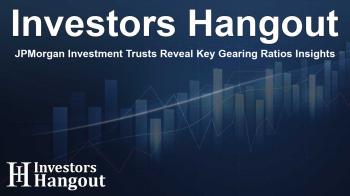JPMorgan Investment Trusts Reveal Key Gearing Ratios Insights

Understanding Gearing Ratios in Investment Trusts
The financial landscape is always shifting, and one of the latest updates comes from JPMorgan Investment Trusts, highlighting their gearing ratios across various investment trust companies. This information is integral for investors seeking to understand the risks and opportunities tied to these financial tools.
Gearing Ratios and Their Significance
Gearing ratios serve as a key indicator of financial health, representing the extent to which a company's operations are funded through borrowed capital as opposed to shareholders' equity. In essence, these ratios reveal how much debt is being utilized to fuel growth. As the significant levels of gearing can introduce volatility into a company's earnings, monitoring these ratios becomes critical for investors.
Current Gearing Ratios Overview
Recently, JPMorgan released its indicative gearing ratios which display a mixed bag of financial strategies across its trusts. For instance, the JPMorgan American Investment Trust PLC noted a gearing ratio of 2.7%, reflecting a modest use of leverage. In stark contrast, the JPMorgan Asia Growth & Income PLC reported a zero gearing ratio, which means it is currently operating without any debt.
Notable Ratios Across Different Trusts
Furthermore, the JPMorgan China Growth & Income PLC showcased a gearing ratio of 4.4%, indicating a well-managed approach to leverage. Other prominent mentions include the JPMorgan Claverhouse Investment Trust PLC at 7.6%, and the JPMorgan European Growth & Income PLC at 4.6%. On an intriguing note, JPMorgan’s Emerging Markets Investment Trust PLC recorded a negative gearing ratio of -0.2%, suggesting it holds liquid assets rather than debt at this time.
Key Players in the Gearing Landscape
Among the various trusts, the JPMorgan European Discovery Trust PLC had a gearing ratio of 6.1% while the JPMorgan Global Emerging Markets Income Trust PLC reported a 6.9% gearing ratio. Conversely, the JPMorgan Global Growth & Income PLC displayed a minor negative gearing ratio of -0.1%
High Gearing Ratios Explained
The highest gearing ratio was attributed to The Mercantile Investment Trust PLC, which reached an impressive 15.5%. This is closely followed by the JPMorgan Japanese Investment Trust PLC, clocking in at a substantial 14.3%. Such high gearing ratios typically indicate that these trusts are utilizing substantial amounts of debt in their operations, which can imply a more aggressive growth strategy.
Implications of Gearing Ratios for Investors
The implications of these ratios are multifaceted. For example, while high gearing can lead to increased returns in favorable market conditions, it also poses risks during downturns, where the need to service debt can strain resources. Therefore, understanding each trust's strategy and how they manage their debt is essential for potential investors.
Impacts on Investment Decisions
As investors assess their options, the reported gearing ratios provide valuable insights into how different trusts are navigating the financial landscape. Those interested in the UK markets might particularly note the gearing ratios from the JPMorgan UK Small Cap Growth & Income PLC at 9.1% and the JPMorgan US Smaller Companies Investment Trust PLC at 7.6%. These figures illustrate the varying approaches in financial leverage, helping investors make informed decisions.
Frequently Asked Questions
What are gearing ratios?
Gearing ratios measure the extent to which a company's operations are funded by debt compared to equity, indicating financial leverage.
Why are gearing ratios important for investors?
They help investors evaluate the risk and potential returns associated with leveraging in various investment trusts.
Which JPMorgan trusts reported negative gearing ratios?
The JPMorgan Emerging Markets Investment Trust PLC, Global Growth & Income PLC, and Indian Investment Trust PLC reported negative gearing ratios.
How do high gearing ratios affect investment decisions?
High gearing ratios can offer higher returns but come with increased risk during unfavorable market conditions.
What is considered a healthy gearing ratio?
A healthy gearing ratio varies by sector, but generally, lower ratios indicate less risk associated with debt, while higher ratios suggest aggressive growth strategies.
About Investors Hangout
Investors Hangout is a leading online stock forum for financial discussion and learning, offering a wide range of free tools and resources. It draws in traders of all levels, who exchange market knowledge, investigate trading tactics, and keep an eye on industry developments in real time. Featuring financial articles, stock message boards, quotes, charts, company profiles, and live news updates. Through cooperative learning and a wealth of informational resources, it helps users from novices creating their first portfolios to experts honing their techniques. Join Investors Hangout today: https://investorshangout.com/
Disclaimer: The content of this article is solely for general informational purposes only; it does not represent legal, financial, or investment advice. Investors Hangout does not offer financial advice; the author is not a licensed financial advisor. Consult a qualified advisor before making any financial or investment decisions based on this article. The author's interpretation of publicly available data shapes the opinions presented here; as a result, they should not be taken as advice to purchase, sell, or hold any securities mentioned or any other investments. The author does not guarantee the accuracy, completeness, or timeliness of any material, providing it "as is." Information and market conditions may change; past performance is not indicative of future outcomes. If any of the material offered here is inaccurate, please contact us for corrections.
